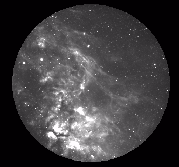
![[Virginia Tech Department of
Physics]](vtlogo.gif)
VTSS
The Virginia Tech Spectral-Line Survey
Mosaics
These images are mosaics produced from 10.67-degree diameter fields obtained
in our survey. A large dynamic range of brightnesses is present in the
original digital data. In order to better display some of that range,
two versions of each mosaic are presented here. The first ("faint
emission") uses a brightness range that displays better the faint
emission present in the data (therefore, bright HII regions appear
saturated). The second ("bright emission") uses a brightness range
that displays better some of the detail present in the bright HII
regions (but, therefore, the faint emission outside those regions is
nearly lost). In all cases, we have used a non-linear transform
from brightness levels in the data to brightness levels in the display, in
order to better represent the large dynamic range. Both
negatives and positives of each mosaic are given.
Mosaic 1: The Cygnus - Lacerta Region
This image extends over an approximate galactic longitude range of 68
degrees to 104 degrees, and an approximate latitude range of -14 degrees
to 5 degrees. The galactic plane runs approximately horizontally across
the top of the mosaic, through the North America Nebula (which lies at the
top-center of the mosaic).
Mosaic 2: The Taurus - Orion - Monoceros Region
This image extends over an approximate galactic longitude range of 177
degrees to 213 degrees, and an approximate latitude range of -21 degrees
to 4 degrees. The galactic plane runs approximately horizontally across
the mosaic, just above the Rosette Nebula
(which lies in the center of the top-left circular field).
Other mosaics will be added as they are produced.
VTSS |
Virginia Tech Physics |
Virginia Tech Astrophysics |
Virginia Tech
![[Virginia Tech Department of
Physics]](vtlogo.gif)

![[Virginia Tech Department of
Physics]](vtlogo.gif)